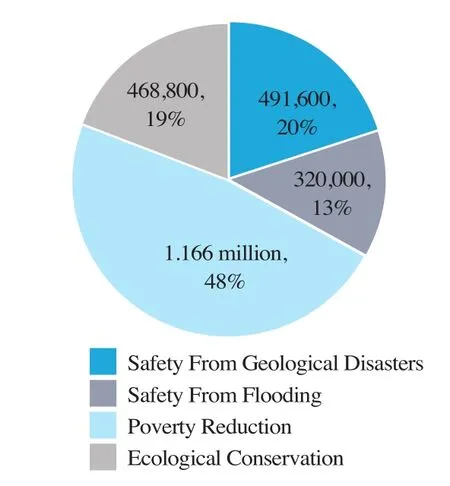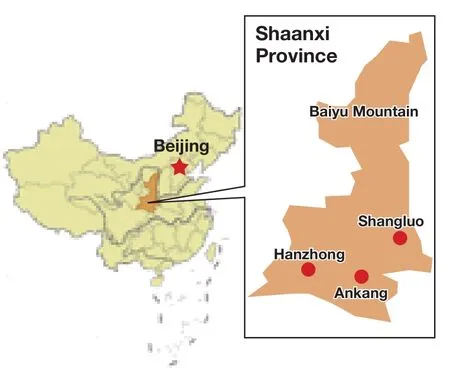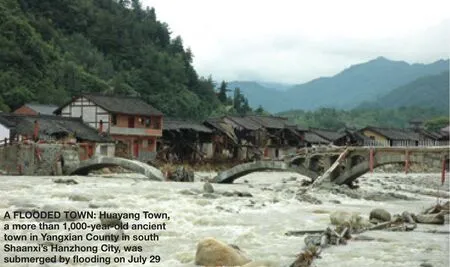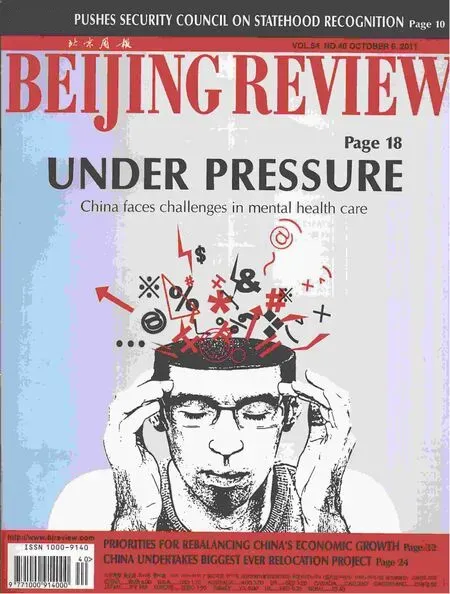Moving to Prosperity
By YIN PUMIN
Moving to Prosperity
By YIN PUMIN
A huge resettlement program is underway in Shaanxi
Whenever there is heavy rain, the residents of villages in the southern part of northwest China’s Shaanxi Province take turns watching for mudslides and landslides. At the first hint of danger, they ring gongs and begin to evacuate the villages. Year in and year out, villagers in this region live in constant fear of disaster.
Despite their vigilance, tragedies remain a regular occurrence. On July 5 torrential rain in Lueyang County, Hanzhong City,triggered a 5,000-cubic-meter landslide that left 18 people dead, according to the local government.
Shaanxi features high mountains and steep hills and is highly prone to natural disasters including mud-rock flows, landslides and fl ooding. According to the Shaanxi Provincial Department of Land and Resources, more than 2,000 geological disasters occurred in the southern part of the province from 2001 to 2010,leaving more than 590 people dead or missing.These disasters incurred a combined direct economic loss of more than 46 billion yuan ($7.20 billion).
Given the high human and economic cost of regular landslides and floods, the provincial government has moved to relocate residents of the hardest-hit areas to other parts of Shaanxi.
On December 7, 2010, the government mapped out an ambitious resettlement plan. More than 2.79 million people in the province’s most disaster-prone and leastdeveloped mountainous areas will be moved over the next 10 years. They include 2.4 million residents in 28 counties in the three southern cities, Hanzhong, Ankang and Shangluo, and 392,000 from poverty-stricken Baiyu Mountain area in the north.
Ultimately it will be the largest resettlement program in China since 1949, moving twice as many people as the Three Gorges Dam Resettlement Program.
“For the residents in south Shaanxi’s mountainous areas, this will not just be a move from danger to safety, but a leap from poverty to a more comfortable life,” said Zhao Zhengyong, Governor of Shaanxi.
A huge project
On May 6, the construction of the first batch of resettlement projects began in Ankang.
“After more than 20 people in a remote,mountainous village in south Shaanxi were instantly buried in a landslide caused by flooding last summer, we decided that we must move our people to safer environments,” Zhao said. “That is our commitment to the people.”
A landslide smothered much of Ankang’s Qiyan Village on July 18, 2010,killing 29 people and flattening many houses. In that month alone, a total of 300 people were reported dead or missing in raintriggered disasters in Shaanxi.
“Such an ambitious program is the result of the provincial government’s determination to free the people in south Shaanxi from the catastrophic natural disasters that have plagued local residents for years,” said Liu Zilong,Deputy Director of the Poverty Alleviation and Development Bureau of Ankang.
According to the plan formulated last December, 26.4 percent of the total population of south Shaanxi will be resettled.
Those who live in villages facing the most serious geological disasters will be the fi rst to be moved. This year, it is estimated that 240,000 residents have been relocated.
Residents of villages that are exceptionally small and are located more than 5 km away from a highway will also be relocated to more accessible locations.
The migrants will be settled in townsand newly constructed villages. “A family of three, when relocated to a city, will be provided with a house of at least 70 square meters,” Zhao said.

Relocated Residents in South Shaanxi
The government will offer a subsidy of 30,000 yuan ($4,688) to each relocated household that builds a new home by themselves. Particularly needy households will receive an additional 10,000 yuan($1,563) each. Relocated rural households will also be provided with arable land to feed themselves.
Newly built settlements will have wellequipped schools and clinics, and residents will also receive vocational training to improve their employment prospects.
The resettlement program is expected to cost more than 110 billion yuan ($17.19 billion), most of which will be funded by the government.
While the villagers of south Shaanxi suffer from excess rainfall, villagers in the province’s northern Baiyu Mountain area must contend with the opposite problem: a lack of precipitation. In extreme cases, villagers living in this area receive only one hard shower of rain per year.
Therefore Shaanxi’s resettlement program also involves residents in the Baiyu Mountain area. Those who can afford apartments are already being encouraged to move to cities. The farminghukou, or registered permanent residence, of these migrants will be changed to a non-farming one, allowing them to enjoy greater access to education,training and employment opportunities.
According to Xie Haomin, Director of the Poverty-Relief Immigration Division of Shaanxi’s Poverty Alleviation Development Office, people living in the Baiyu Mountain area with an annual income less than 1,500 yuan ($234) will soon be moved to more livable locations.
The government will support those being relocated by offering them vocational training programs and farming equipment.
“The government will respect the wishes of its citizens during the relocation process,”Governor Zhao said.
Great challenges
Although Governor Zhao said he was con fi dent the government would succeed in completing the resettlement program on schedule, he acknowledged it would not be easy.
Some scholars also cautioned there were many complex, long-term challenges ahead for such a huge and expensive program.Shortages of funds and farming and residential land for migrants are cited as major stumbling blocks. Without proper planning,it’s feared the resettlement program may simply cause further suffering.
According to the provincial government’s plan, some of those relocated will be moved to nearby cities and towns while others will be settled in specially constructed villages. Some residents will be given the option to fi nd new housing on their own. The total area of new resettlements will exceed 10,000 hectares.
Such an enormous program will consume a massive amount of the province’s land and fi nancial resources.
However, half of south Shaanxi is prone to geological disasters, therefore only a very limited amount of “safe” land is available for accommodating migrants.

In Ankang, for example, only the city center and the county seats of Pingli and Hanyang have much flat land. “There is little even ground and virtually no room for further municipal development on any scale,” said Wang Fuxiang, Deputy Director of Ankang’s Bureau of Land Resources. He also warned the other seven county seats in the city, which are built on slopes or gullies,were “not just unsafe but extremely unsafe.”
According to Ma Peijun, Director of the Geological Environment Monitoring Station at Lueyang’s Department of Land and Resources, after the 8.0-magnitude Wenchuan earthquake in neighboring Sichuan Province in May 2008, the number of locations prone to natural disasters in Lueyang jumped from 229 to around 630 and the number of villagers requesting relocation also increased.
Even at present the county’s land shortage is so acute that government offices cannot be relocated despite being threatened by potential geological hazards.
Meanwhile, Zhao Fasuo, Director of the Institute of Geology at Chang’an University in Xi’an, capital of Shaanxi Province, worries the massive relocation program will encounter the same problems experienced by a similar program in Ningqiang County in the province, where local residents were moved to an area that was later found to be prone to disasters.
“They did an evaluation and found the new settlement was only a little safer than the original location. You couldn’t call it completely safe,” Zhao said.
Wang is fully aware of the situation. “At best, we’re moving from somewhere that will see a disaster every 10 years to somewhere that will see one every two or three decades,” he said.
Finding suitable locations for resettling migrants is just the beginning. The cost of land acquisition as well as building houses and public infrastructure will be a big challenge.
Governor Zhao has pledged to minimize the burden on relocated households by raising funds from various channels, including securing financial support from the Central Government.
To raise capital for the program, the Shaanxi Provincial Government founded the South Shaanxi Migration and Settlement Engineering Co. Ltd. on May 6. Of the 6 billion yuan ($939 million) required for the fi rst stage of relocation, 1 billion yuan ($157 million) will come from the provincial budget and 2 billion yuan ($313 million) from an investment by the Shaanxi Nonferrous Metals Holding Group. The remaining 3 billion yuan ($469 million) will be raised through bank loans.
“But besides the land and funding shortages, this program also faces the daunting task of supporting migrants’ livelihoods for years after their resettlement.,” said Mao Yanlong, a professor at Chang’an University’s Geological Institute.

FENG GUO


